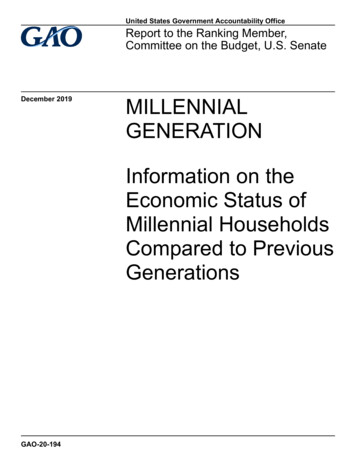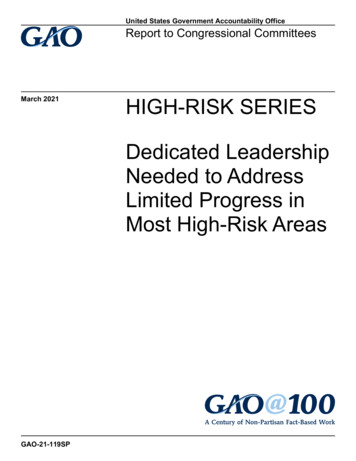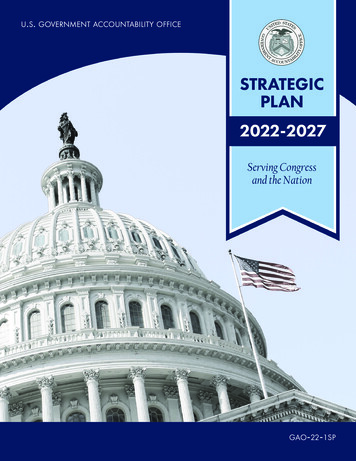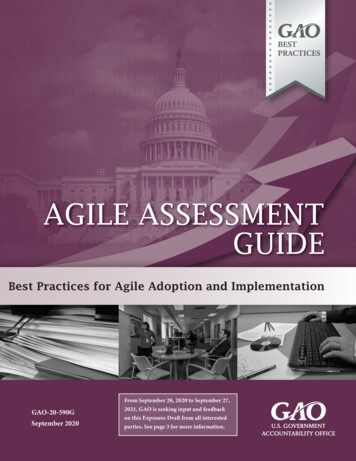
Transcription
United States Government Accountability OfficeReport to the Ranking Member,Committee on the Budget, U.S. SenateDecember 2019MILLENNIALGENERATIONInformation on theEconomic Status ofMillennial HouseholdsCompared to PreviousGenerationsGAO-20-194
December 2019MILLENNIAL GENERATIONInformation on the Economic Status of MillennialHouseholds Compared to Previous GenerationsHighlights of GAO-20-194, a report to theRanking Member of the Committee on theBudget, U.S. SenateWhy GAO Did This StudyWhat GAO FoundThe idea that individuals should havethe opportunity to economically advancebeyond the circumstances of their birthis a familiar element of the AmericanDream. In an economically mobilesociety, it is possible for individuals toimprove their economic circumstancesthrough effort, education, investment,and talent. In addition to opportunitiesthrough the private, public, and nonprofitsectors, the federal government alsopromotes economic mobility throughmany efforts, including supportingeducation, job training, businessincentives and development, and childhealth and well-being programs.Recent research indicates that, across three key measures, economic mobility inthe United States is limited. Specifically, the Millennial generation (those bornbetween 1982 and 2000) might not have the same opportunity as previousgenerations had to fare better economically than their parents. According tostudies GAO reviewed, the share of people making more money than theirparents at the same age (absolute mobility) has declined over the last 40 years,and the chances of moving up the income distribution (relative mobility) havebeen flat over time. Using a third measure of economic mobility (intergenerationalincome elasticity), researchers have found that income in adulthood is linked tohow much a person’s parents made, and that between one-third and two-thirds ofeconomic status is passed down from parents to children. This is especially trueof the lowest and highest income groups. Researchers also identified race andgeography as key determinants of an individual’s economic mobility.However, a recent survey indicates thatover approximately the last two decadesfewer people report being satisfied withthe opportunity to get ahead by workinghard. According to recent studies, theMillennial generation, who comprise thelargest portion of the Americanworkforce, report feeling overwhelmedby their financial situation andconcerned about their future financialsecurity.GAO was asked to review trends ineconomic mobility and Millennials’economic situation compared toprevious generations. This reportexamines (1) what is known aboutintergenerational income mobility, and(2) how the financial circumstances ofMillennials compare to previousgenerations. To perform this work GAOconducted an extensive literature reviewand analyzed data from the nationallyrepresentative Survey of ConsumerFinances.Millennials have different financial circumstances than Generation X (born 19651981) and Baby Boomers (born 1946-1964), and in light of flat or decliningeconomic mobility, there is uncertainty about how they will fare financially as theyage. A snapshot of data that allowed GAO to compare Millennials aged 25-34 tothe previous two generations at similar ages showed that Millennial householdswere more likely than other generations to be college educated; however,incomes have remained flat across the three generations, implying thatMillennials have not yet benefited from the potential additional lifetime incomeearned by college graduates. Millennial households had significantly lowermedian and average net worth than Generation X households at similar ages(see figure), especially among those with low net worth. Median net worth for thelowest quartile of Baby Boomers and Generation X was around zero, but it wassubstantially negative for Millennials, indicating that debt was greater than assetsfor the median low net worth Millennial household. Regarding assets, asignificantly lower percentage of Millennials owned homes compared to previousgenerations at similar ages, but had retirement resources at rates comparable toGeneration X and Baby Boomers. Finally, Millennials were more likely to havestudent loan debt that exceeded their annual income. It remains to be seen howthese factors will affect Millennials’ financial circumstances in the long run,including retirement.Estimated Median Net Worth for Baby Boomer, Generation X, and Millennial Households in the25-34 Age Range, in 2016 DollarsView GAO-20-194. For more information,contact Charles Jeszeck at (202) 512-7215 orjeszeckc@gao.gov.United States Government Accountability Office
ContentsLetter1BackgroundEconomic Mobility is Linked to Parental Income, and Varies byRace and GeographyMillennials Have Similar Average Incomes and Lower AverageNet Worth Compared to Previous Generations Despite BeingMore EducatedAgency Comments41729Appendix IObjectives, Scope, and Methodology30Appendix IIGAO Contact and Staff Acknowledgments40Table 1: Economic Mobility Studies Reviewed359TableFiguresFigure 1: Absolute and Relative Economic MobilityFigure 2: Measuring Economic Mobility with IntergenerationalIncome ElasticityFigure 3: Characteristics of Millennial Households Compared toPrevious Generations at 25-34 Years OldFigure 4: Estimated Absolute Mobility, by Birth YearFigure 5: Map of Relative Economic Mobility by Commuting ZoneFigure 6: Estimated Average Income for Baby Boomer,Generation X, and Millennial Households in the 25-34Age Range, in 2016 DollarsFigure 7: Estimated Median Income for Baby Boomer, GenerationX, and Millennial Households in the 25-34 Age Range, in2016 DollarsFigure 8: Estimated Average Net Worth for Baby Boomer,Generation X, and Millennial Households in the 25-34Age Range, in 2016 DollarsFigure 9: Estimated Median Net Worth for Baby Boomer,Generation X, and Millennial Households in the 25-34Age Range, in 2016 DollarsPage i568101419192021GAO-20-194 Millennial Generation
Figure 10: Estimated Median Net Worth by Net Worth Quartile forBaby Boomer, Generation X, and Millennial Householdsin the 25-34 Age Range, in 2016 DollarsFigure 11: Estimated Percentage of Homeowners in the 25-34Age Range, by GenerationFigure 12: Estimated Percentage of Households in the 25-34 AgeRange with Any Retirement Resources, by GenerationFigure 13: Estimated Average Value of Retirement Accounts forHouseholds in the 25-34 Age Range, by Generation, in2016 DollarsFigure 14: Estimated Percentage of Households in the 25-34 AgeRange with Student Loans, by GenerationFigure 15: Estimated Ratio of Student Loan Amount to YearlyIncome, Conditional on Having a Student Loan, byGenerationFigure 16: Estimated Average Student Loan-to-Income Ratios forGeneration X and Millennial Households in the 25-34 AgeRange, Conditional on Having a Student Loan, by AIRSSCFdefined benefitdefined contributionintergenerational income elasticityindividual retirement accountInternal Revenue ServiceSurvey of Consumer FinancesThis is a work of the U.S. government and is not subject to copyright protection in theUnited States. The published product may be reproduced and distributed in its entiretywithout further permission from GAO. However, because this work may containcopyrighted images or other material, permission from the copyright holder may benecessary if you wish to reproduce this material separately.Page iiGAO-20-194 Millennial Generation
Letter441 G St. N.W.Washington, DC 20548December 13, 2019The Honorable Bernard SandersRanking MemberCommittee on the BudgetUnited States SenateDear Senator Sanders:The idea that individuals should have the opportunity to advanceeconomically beyond the circumstances of their birth is a familiar elementof the American Dream. 1 In an economically mobile society, it is possiblefor individuals to improve their economic circumstances through effort,education, investment, and talent. In addition to opportunities through theprivate, public, and nonprofit sectors, the federal government alsopromotes economic mobility through many efforts, including supportingeducation, job training, homeownership, business incentives anddevelopment, and child health and well-being. 2 Intergenerational incomemobility, or how members of a generation compare to their parents interms of income or rank in the income distribution, is often used tocapture the degree to which a society is economically mobile. 3 However,recent research indicates a falling share of people are earning more (ininflation adjusted dollars) than their parents earned at similar ages. 41Lawrence R. Samuel, The American Dream: A Cultural History, (Syracuse, New York:Syracuse University Press, 2012) pp. 3, 6-7.2Adam Carasso, Gillian Reynolds, and C. Eugene Steuerle, How Much Does the FederalGovernment Spend to Promote Economic Mobility and for Whom? (Washington, D.C.:Pew Charitable Trusts, 2008). For example, recognizing that homeownership has thepotential to help families achieve long-term financial stability and revitalize and stabilizecommunities, the federal government has long sought to make homeownership moreaffordable for American families. See also GAO, HUD Homeownership Programs,GAO-06-677 (Washington, D.C.: June 30, 2006).3Sarah Donovan, In Focus: Intergenerational Income Mobility, IF10586 (Washington,D.C.: Congressional Research Service, 2017).4Approximately 90 percent of 30-year-olds born in 1940 earned more in 1970 (in inflationadjusted dollars) than their parents had at the same age. Only about 50 percent of 30year-olds born in the 1980s out-earn what their parents made at a similar age. Raj Chettyet al., “The Fading American Dream: Trends in Absolute Income Mobility since 1940,”Science, vol. 356, no. 6336 (2017): pp. 398-406.Page 1GAO-20-194 Millennial Generation
In 2018, an estimated 63 percent of Americans were satisfied with “theopportunity for a person to get ahead in this nation by working hard,”down from an estimated 76 percent in 2001. 5 Some of this decrease maybe attributable to attitudes of those in the Millennial generation (born from1982 to 2000). According to recent studies, Millennials, who now make upthe largest portion of the American workforce, report feeling overwhelmedby their financial situation and concerned about their economic futures. 6In light of these issues, you asked us to review trends in economicmobility and Millennials’ economic situation, including how Millennials arefaring financially compared to previous generations. This report examines(1) what is known about intergenerational income mobility, and (2) howthe financial circumstances of Millennials compare to previousgenerations.To report on what is known about intergenerational income mobility(which we use interchangeably with “economic mobility”) we conducted aliterature review of relevant, recent economic studies. To be included,studies had to (1) produce original estimates of economic measures ofintergenerational income mobility; 7 (2) focus on the United States (U.S.);(3) be published in the last 5 years (2014-2019), or 2 years if a workingpaper (2017-2019); and (4) be published in a U.S.-based publication. Weidentified the majority of the studies through systematic searches ofdatabases. We also identified several studies through other research andexpert interviews. We examined 20 studies that met our selection criteriaand that we determined in our technical review were reliable for the5Frank Newport, “Majority in US Satisfied with Opportunity to Get Ahead,” Gallup (Mar. 7,2018), accessed September 2019, fiedopportunity-ahead.aspx.6More than one in three American labor force participants (35 percent) are Millennials,making them the largest generation in the U.S. labor force. Richard Fry, Millennials Arethe Largest Generation in the US Labor Force (Pew Research Center, Apr. 11, 2018). Seealso: Society of Actuaries, Aging and Retirement: Difficulties in Gaining Financial Securityfor Millennials (2018) and Society of Actuaries, Financial Priorities, Behaviors andInfluence on Retirement (2018).7Studies that only summarized other published research were excluded.Page 2GAO-20-194 Millennial Generation
purpose of providing information on economic mobility. 8 The bibliographyin appendix I lists all of the studies included in the literature review.To compare the financial circumstances of Millennials to the previous twogenerations, Generation X and Baby Boomers, we used the Survey ofConsumer Finances (SCF), typically a triennial survey of U.S. householdssponsored by the Board of Governors of the Federal Reserve System incooperation with the Department of Treasury. Every 3 years, SCF staffinterview a different group of households with the goal of creating asample that is representative of households across economic strata,including the top of the wealth distribution. Millennials are defined aspeople born from 1982 to 2000 (i.e., those who were 18-37 years old in2019). We defined young households in each generation as those inwhich either the head, and/or spouse or partner, was 25-34 years old. Wecompared young Millennial households in 2016 to young Generation X(born 1965-1981) and Baby Boomer (born 1946-1964) households in2001 and 1989, respectively. 9We analyzed SCF data to estimate income, net worth, assets, and debtfrom the three generations at points in time when each was at a similaryoung age. We defined household income as the sum of income acrossall sources, such as wages and salaries, including interest on financialassets or benefits from social safety net programs. We defined householdnet worth as assets minus debt. Assets include savings accounts, stocks,bonds, and retirement accounts, such as 401(k)s or individual retirementaccounts. Assets could also be nonfinancial, including the value ofhouses or vehicles. Households could have financial resources outside ofnet worth, including future income from defined benefit (DB) retirementplans or Social Security; however, we did not attempt to estimate thefuture value of these financial resources in our net worth calculation giventhe long time horizon to retirement for young Millennials. All financialestimates presented in this report are in 2016 dollars.8Each study that met our selection criteria was reviewed by at least one GAO analyst andat least two GAO economists. The economists carried out a technical review thatexamined each study overall, as well as each study’s methodology and limitations, inparticular.9The data analysis compares three cross-sections and is not longitudinal in nature, nordoes it account for differences in macroeconomic conditions at the time the data werecollected. A household containing members of more than one generation would beclassified based on the survey year and whichever head/spouse was 25-34 years old atthe time of survey.Page 3GAO-20-194 Millennial Generation
We reviewed documentation about the SCF, tested the data foranomalies, and reviewed related controls. We determined that the SCFdata were sufficiently reliable for the purposes of this report. Seeappendix I for more detailed information about our scope andmethodology.We conducted this performance audit from November 2018 to December2019 in accordance with generally accepted government auditingstandards. Those standards require that we plan and perform the audit toobtain sufficient, appropriate evidence to provide a reasonable basis forour findings and conclusions based on our audit objectives. We believethat the evidence obtained provides a reasonable basis for our findingsand conclusions based on our audit objectives.BackgroundMeasures of EconomicMobilityIntergenerational economic mobility describes how people’s incomes inadulthood compare with their parents’ incomes in the past or at similarages. 10 Several measures are used to assess the degree of economicmobility, but fundamentally, a society exhibits more economic mobilitywhen incomes are less related to parents’ income. By contrast, whereeconomic mobility is lacking, individuals are more likely to remain at theeconomic position of their upbringing.Economists traditionally measure economic mobility in three ways: 11Absolute economic mobility - whether people make more money (ininflation-adjusted dollars) than their parents did at a similar age (seefig. 1). For example, in 1970, 92 percent of 30-year-olds made moremoney in inflation-adjusted terms than their parents did at similarages, implying an absolute economic mobility rate of 92 percent. 12 10Donovan, In Focus: Intergenerational Income Mobility, p.1.11Sociologists also study mobility, and their measures typically include factors related tooccupational status and class. In this report, we focus exclusively on estimates ofintergenerational income mobility.12Chetty et al., “The Fading American Dream: Trends in Absolute Economic Mobility since1940,” p. 398.Page 4GAO-20-194 Millennial Generation
Relative economic mobility - whether people are at a higher incomepercentile compared to their parents’ income percentile in the past.For example, according to one estimate, there was an 8 percentchance that a person born in the United States from 1980-1982 toparents in the bottom 20 percent of the income distribution wouldmove to the top 20 percent of the income distribution for their birthcohort by the time he or she was approximately 30 years old. 13Figure 1: Absolute and Relative Economic MobilityNote: The red line in the left-hand panel of this graphic demonstrates how children may earn moremoney than their parents did, yet occupy the same income quintile—this represents positive absoluteeconomic mobility and flat relative economic mobility. The red line in the right-hand side depicts ascenario in which children earn more money and occupy a higher income rank than their parentsdid—this represents positive absolute and relative economic mobility. Intergenerational income elasticity (IGE) 14 - the strength of therelationship between a person’s income and their parents’ income. 1513Raj Chetty et al., “Where is the Land of Opportunity? The Geography ofIntergenerational Mobility in the United States,” The Quarterly Journal of Economics, vol.129, no. 4 (2014): pp. 1553-1623.14An elasticity measures how sensitive one variable is to the change in another variable—in this case, how sensitive children’s future income is to a change in their parents’ income.IGE is estimated by regressing the natural log of children’s income (or mean income overa period of years) on the natural log of parents’ income (or mean income over the sameage range as children’s income is measured), with the resulting coefficient providing thepercent change in children’s income given a 1 percent change in parents’ income. Seeappendix I.Page 5GAO-20-194 Millennial Generation
The higher the number, between zero and one, the greater therelationship between parental income and children’s adult income(see fig. 2). For example, if IGE is zero, there is complete mobilitybetween generations; parents’ income does not influence theirchildren’s future income at all. If IGE is 1, there is no mobility betweengenerations, as everyone stays at the same income level in whichthey were born. IGE measures the “persistence of advantage” fromone generation to the next at all points along the economic ladder andtherefore captures how much inequality is passed down throughgenerations.Figure 2: Measuring Economic Mobility with Intergenerational Income ElasticityA single standard measure of intergenerational economic mobility doesnot exist, and some researchers use more than one. Each of the threemeasures provides some insight into the level of opportunity available forpeople to better their economic circumstances relative to the15Although IGE is strictly a measure of the persistence of economic differences acrossgenerations, it is commonly interpreted as a measure of economic mobility that indexesthe degree of departure from equal opportunity. Because IGE is unit-free, it can becompared across time and countries. IGE reflects the level of inequality in the incomedistribution and indicates how much of that inequality is passed on—it can be seen as asimple descriptive benchmark indicating the share of economic advantage that istransmitted from parents to children. Pablo Mitnik, Victoria Bryant, and David Grusky, AVery Uneven Playing Field: Economic Mobility in the United States (Stanford Center onPoverty and Inequality, 2018).Page 6GAO-20-194 Millennial Generation
circumstances of their birth. 16 Many factors may be related to the level ofeconomic opportunity available to an individual, including but not limitedto overall macroeconomic conditions (e.g., economic growth), education,race, gender, geography (the region, commuting zone, county, orneighborhood in which a person lives), health care, and neighborhoodcharacteristics.Characteristics ofMillennialsMillennials have a number of unique characteristics that distinguish themfrom previous generations. According to data from SCF, Millennials are amore diverse group than previous generations—40 percent of Millennialhouseholds are headed by someone who belongs to a racial or ethnicminority group. Millennials are also the most educated generation to datein terms of college degree attainment (see fig. 3). An estimated 62percent of Millennial households had someone with at least anassociate’s degree in 2016. 17 Not only did Millennial households havemore college degrees overall, a greater percentage of Millennialhouseholds in 2016 had advanced degrees, including master’s, doctorate,and professional degrees, compared to previous generations at similarages. Meanwhile, only 44 percent of Millennials 25-34 years old weremarried or living with a partner and had children in 2016, while 54 percentof Baby Boomers were partnered and had children by age 34. 1816Each of these measures also has limitations, especially related to the way data arecollected. For instance, small sample sizes in longitudinal data and limited data on veryhigh income earners or non-income earners can affect all three measures. In addition, theway in which the data for most datasets are collected emphasizes intergenerationaleconomic mobility for fathers and sons, and as a result, analysis of women’s economicmobility has been limited. However, advances have been made in developing newdatasets in the past decade, particularly those based on tax data.17Our analysis was at the household level because this is how the SCF is structured.Other research at the individual level has found that 46 percent of individual youngMillennials had at least an associate’s degree in 2017. See U.S. Department of Education,National Center for Education Statistics, The Condition of Education 2018, NCES 2018144 (Washington, D.C.: 2018).18According to research conducted by the Census Bureau using the Current PopulationSurvey, more young adults ages 25-34 are unmarried and living with a partner than in thepast. In 2018, 15 percent of young adults ages 25-34 lived with an unmarried partner.About 40 percent lived with a spouse, roughly half as many as 50 years ago. SeeBenjamin Gurrentz, “For Young Adults, Cohabitation Is Up, Marriage Is Down: Living withan Unmarried Partner Now Common for Young Adults,” America Counts: Stories Behindthe Numbers (Washington, D.C.: U.S. Census Bureau, Nov. 15, 2018).Page 7GAO-20-194 Millennial Generation
Figure 3: Characteristics of Millennial Households Compared to Previous Generations at 25-34 Years OldNote: Because the age ranges for the generations in each year vary, we limit our analysis to onlythose households that have either a head or spouse/partner between 25-34 years of age in the yearthe data were collected in order to compare individuals in the same age ranges across years. BabyBoomers comprise those born between 1946 and 1964, Generation X are those born between 1965and1981, and Millennials are those born between 1982 and 2000. College degree is defined asassociate’s degree or higher. Advanced degree is defined as master’s, doctorate, or professionaldegree. All estimates are within a /-1 percentage point margin of error. Due to rounding, percentagebreakdowns may not add up precisely to the totals provided.Page 8GAO-20-194 Millennial Generation
Economic Mobility isLinked to ParentalIncome, and Variesby Race andGeographyThe 20 studies that we reviewed indicate that economic mobility hasremained flat or declined in the United States over the last 40 years; noneof the studies we reviewed found that economic mobility has increased(see text box). 19 Additionally, estimates of intergenerational incomeelasticity (IGE) suggest that economic status persists across generations,particularly for the lowest and highest income groups. Studies identifiedparental income, race, and geography as key determinants of one’seconomic mobility. These findings could have future implications forMillennials.Parental Income is a KeyPredictor of EconomicMobility, Especially amongthe Lowest and HighestEarnersStudies we reviewed indicate a flat or downward trend on two measuresof economic mobility in the United States over the last several decades,and limited current mobility based on a third measure. 20Absolute mobility has fallen. The share of people making moremoney than their parents at the same age declined between 1970 and2010 (see fig. 4). 21 One study attributes this decline to an unequaldistribution of economic growth, noting it has primarily benefited thehighest earners. 22 It remains to be seen if this downward trend willcontinue for the Millennial generation. Measures of Economic MobilityThe three key measures of economic mobilityare: Absolute mobility: whether people makemore money (in inflation-adjusted dollars)than their parents did at similar ages. Relative mobility: whether people are at ahigher income percentile compared totheir parents’ income percentile in thepast. Intergenerational income elasticity: thestrength of the relationship between aperson’s income and their parents’income.Source: GAO analysis of economic mobility studies. GAO-20-19419See appendix I for a description of how we selected the 20 studies reviewed and for alist of the studies. This section describes findings from our review of the studies, notoriginal data analysis conducted by GAO.20Fourteen of the studies we reviewed examined trends in economic mobility in the UnitedStates.21Two studies we reviewed examined trends in absolute mobility and found it hasdeclined.22Chetty et al., “The Fading American Dream,” p. 405.Page 9GAO-20-194 Millennial Generation
Figure 4: Estimated Absolute Mobility, by Birth YearNote: The authors used tax data to construct their estimates. Absolute mobility is measured bywhether people make more money (in inflation adjusted dollars) than their parents did at similar ages.The authors conducted several sensitivity analyses of the result, including using alternative inflationadjustments, comparing parents and children at different ages, and adjusting for family size andnumber of earners, and found their conclusions to be robust. Relative mobility has remained flat. The chances of individualssurpassing their parents’ income percentile rank have remained stableover time. 23 Despite this stability, researchers indicate that risingeconomic inequality suggests that individuals need to earn moremoney than before to advance in income ranks, as the gaps betweenranks have grown. 24 IGE indicates that economic status persists across generations.The range of researchers’ IGE estimates in the United States indicate23Five of the studies we reviewed examined trends in relative mobility. Three of thesestudies found that relative mobility has remained stable and one found it has decreased.The fifth study examined geographic trends.24Four of the studies we reviewed found that rising inequality could limit economicmobility.Page 10GAO-20-194 Millennial Generation
that 32-68 percent of an individual’s income can be explained by theirparents’ income. 25IGE indicates that parental income is a key determinant of one’s incomein adulthood, and this is especially true for low- and high-earners. Severalresearchers found that the persistence of economic status from onegeneration to the next is greatest for the lowest- and highest-earningfamilies. 26 One study of Internal Revenue Service data found that amongadults in the bottom and top 10 percent of the income distribution, 60-65percent of an individual’s income could be explained by parentalincome. 27Education can play a role in increasing an individual’s earnings, but theresearch we reviewed indicates educational attainment itself is affectedby parental income. Children from higher income families are more likelyto attend college. 28 Additionally, children of families in the bottom incomequartile are less likely than children in the upper two income quartiles tograduate from college, and to therefore reap the economic benefits of acollege degree. 29 Even among Millennials—the most educated25Eleven studies we reviewed provided estimates of IGE. IGE is a measure of how mucha higher parental income in childhood translates to higher income for the child inadulthood. For example, an IGE of .32 implies that having parents with a 10 percenthigher income is associated with the child having 3.2 percent higher income in adulthood.Similarly, an IGE of .6 means that having parents with a 10 percent higher income isassociated with the child having a 6 percent higher income in adulthood.26Four studies we reviewed found economic persistence to be greatest for families at thelowest and highest ends of the income distribution.27Pablo Mitnik et al., New Estimates of Intergenerational Mobility Using AdministrativeData, Statistics of Income Working Paper (Washington, D.C.: Internal Revenue Service,2015).28Five studies we reviewed cited parental income as a predictor o
A snapshot of data that allowed GAO to compare Millennials aged 25-34 to . Figure 16: Estimated Average Student Loan-to-Income Ratios for Generation X and Millennial Households in the 25-34 Age Range, Conditional on Having a Student Loan, by Income Quartile 27 . Abbreviations .










